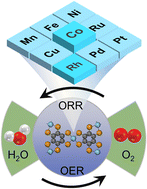文章“Two-dimensional metal–organic frameworks as bifunctional electrocatalysts for the oxygen evolution reaction and oxygen reduction reaction (OER/ORR): a theoretical study”被 Physical Chemistry Chemical Physics 杂志(IF = 2.9)接收。2021级硕士研究生许飞飞同学是第一作者,赵文副教授为通讯作者。
Effective bifunctional catalysts are needed for the two main processes in metal–air batteries (oxygen evolution reaction and oxygen reduction reaction (OER/ORR)) to increase efficiency. Herein, we systematically investigate the stability, electronic structure, and catalytic performance of the OER/ORR of two-dimensional (2D) conducting metal–organic frameworks (MOFs) M3(C6Se6)2 (M = Ti, V, Cr, Mn, Fe, Co, Ni, Cu, Zr, Nb, Mo, Ru, Rh, Pd, Ir, and Pt) by first-principles calculations. The results show that Co3(C6Se6)2 has an overpotential of 0.51 V and 0.3 V for the OER and ORR, respectively, and Rh3(C6Se6)2has an overpotential of 0.53 V and 0.29 V for the OER and ORR, respectively, which are very promising bifunctional catalysts. In addition, Ir3(C6Se6)2 is a very promising ORR catalyst with a low overpotential of 0.34 V. Volcano plots and contour maps of OER/ORR activity versus intermediate adsorption strength were established to describe the activity trend of M3(C6Se6)2 based on the relationship of adsorbed intermediates. Furthermore, the d-band center theory and crystal orbital Hamilton populations (COHPs) were used to relate the OER/ORR activity to the d-electrons of the central metal. Our study not only provides a novel bifunctional electrocatalyst but also provides some references for other 2D MOFs as electrocatalysts.

